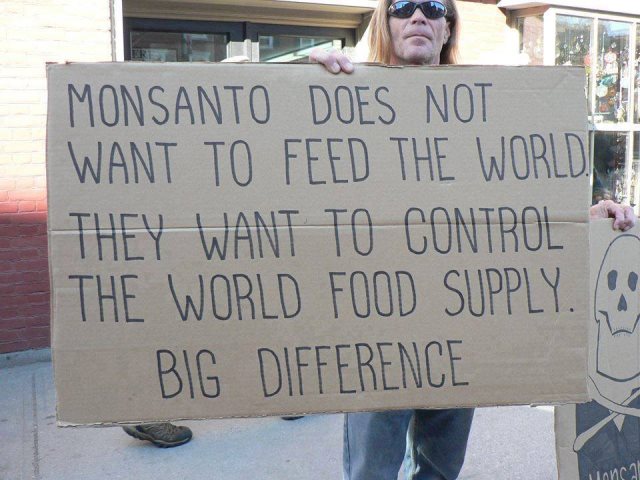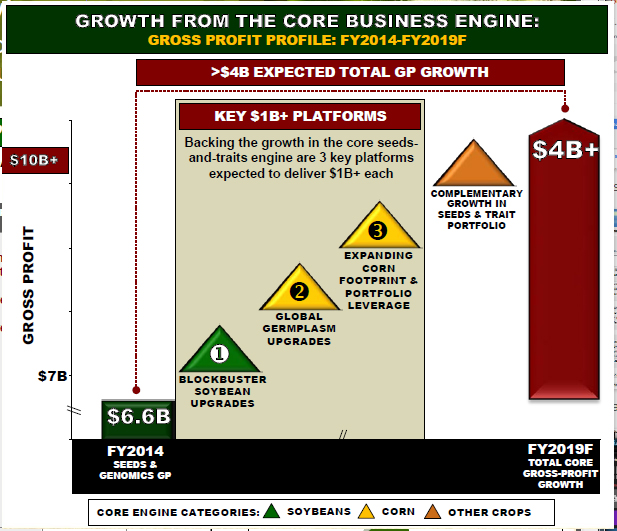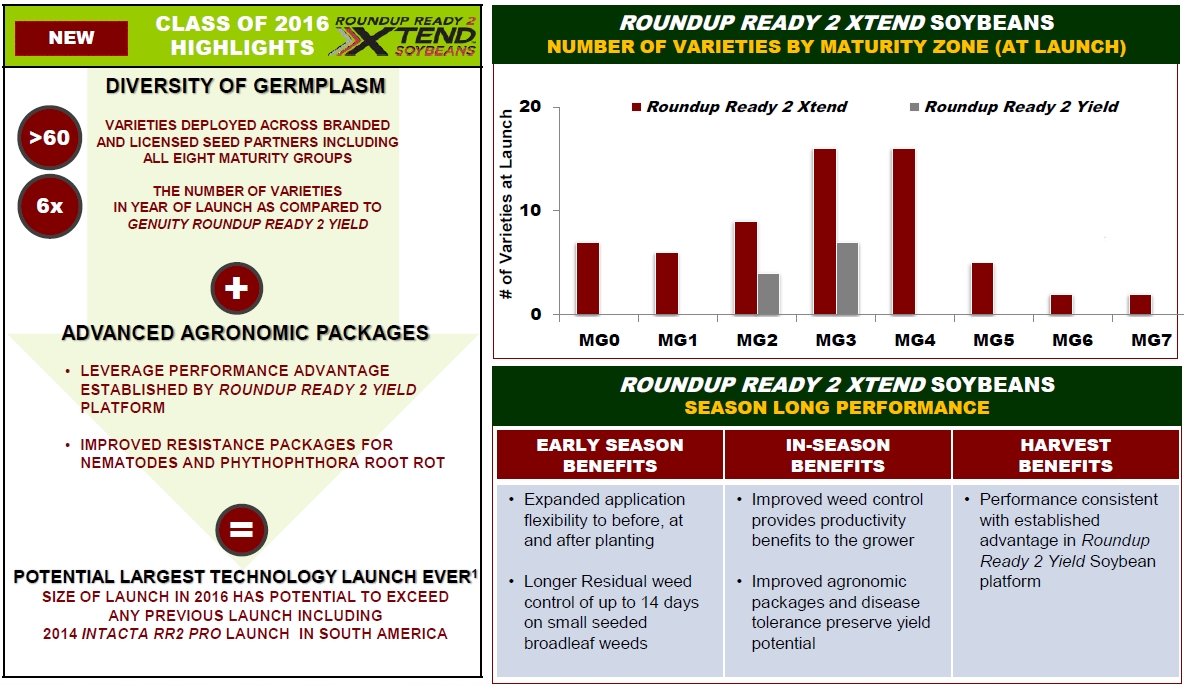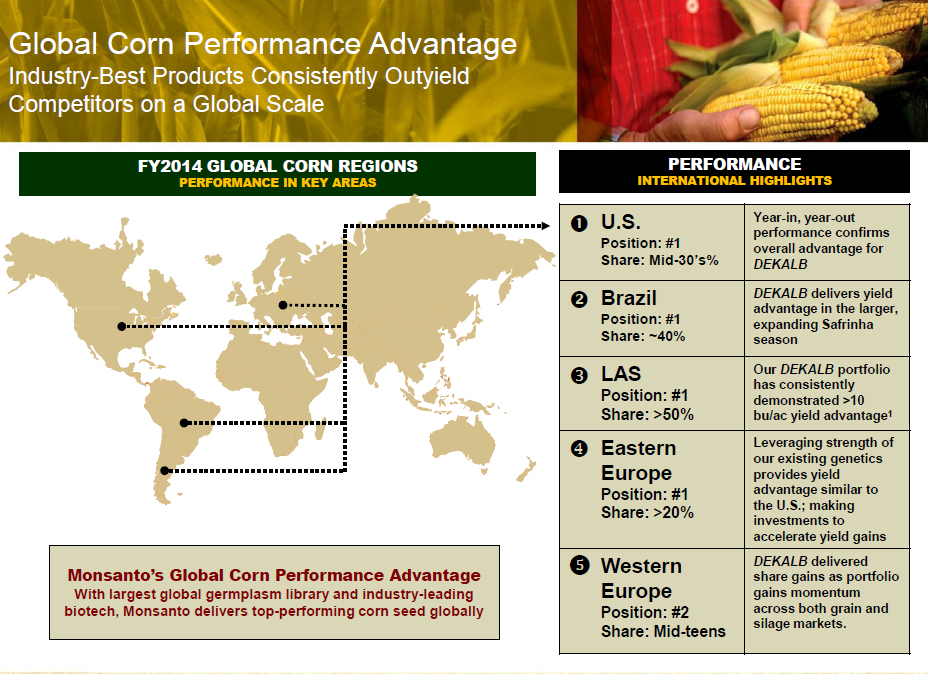8 Reasons Monsanto is Far From Finished
 With that said, these are some of the most notable updates in the latest Monsanto earnings report.
With that said, these are some of the most notable updates in the latest Monsanto earnings report.

For comparison to the last few years...


The deregulation of these new crops will be finalized after the 30 day comment period ended Monday, January 12th. The USDA news section had not been updated at the time of this article.

Posted 1 hour ago by The Anti-Media
Thanks to: http://theanti-media.blogspot.com/
| WTF News | Monsanto's reported 34 percent earings decline, which was hinted at last quarter as we reported, was released during the media frenzy after the terror attacks in Paris.“Globalized industrialized food is not cheap: it is too costly for the Earth, for the farmers, for our health. The Earth can no longer carry the burden of groundwater mining, pesticide pollution, disappearance of species and destabilization of the climate. Farmers can no longer carry the burden of debt, which is inevitable in industrial farming with its high costs of production. It is incapable of producing safe, culturally appropriate, tasty, quality food. And it is incapable of producing enough food for all because it is wasteful of land, water and energy. Industrial agriculture uses ten times more energy than it produces. It is thus ten times less efficient.” ― Vandana Shiva
The purpose of this article is to outline why Monsanto is not losing as much ground to the food revolution as activists would suggest, and a more focused effort is required to make more permanent progress. Progress in this case is defined as 'small-scale organic farming' which is the only way to feed the growing world as described by a recent report from the U.N. Commission on Trade and Development.AP Monsanto said Wednesday that its earnings fell 34 percent in its first fiscal quarter as South American farmers cut back on planting corn, reducing demand for the company’s biotech-enhanced seeds. U.S. farmers harvested record crops of soybeans and corn last year, sending prices on those food staples to their lowest levels in years. That has resulted in farmers in South America and elsewhere reducing the number of acres they dedicate to corn. The company said lower corn plantings in the U.S. will likely reduce second quarter results by 5 to 10 percent compared with the prior year. Monsanto said its business was also affected by reduced cotton planting in Australia and a shift in timing for its chemical business. The St. Louis-based company reported a profit of $243 million, or 50 cents per share, down from $368 million, or 69 cents per share, in the prior year period. Earnings, adjusted to account for discontinued operations, came to 47 cents per share in the most recent quarter. The results topped Wall Street expectations. The average estimate of analysts surveyed by Zacks Investment Research was for earnings of 34 cents per share.
GMO technologies are profit focused solutions to problems that require decentralization and open source technology to lower costs of food for billions of people.Institute for Agriculture and Trade Policy Transformative changes are needed in our food, agriculture and trade systems in order to increase diversity on farms, reduce our use of fertilizer and other inputs, support small-scale farmers and create strong local food systems. That’s the conclusion of a remarkable new publication from the U.N. Commission on Trade and Development (UNCTAD). The report, Trade and Environment Review 2013: Wake Up Before it is Too Late, included contributions from more than 60 experts around the world (including a commentary from IATP). The report includes in-depth sections on the shift toward more sustainable, resilient agriculture; livestock production and climate change; the importance of research and extension; the role of land use; and the role of reforming global trade rules. The report links global security and escalating conflicts with the urgent need to transform agriculture toward what it calls “ecological intensification.” The report concludes, “This implies a rapid and significant shift from conventional, monoculture-based and high-external-input-dependent industrial production toward mosaics of sustainable, regenerative production systems that also considerably improve the productivity of small-scale farmers.” The UNCTAD report identified key indicators for the transformation needed in agriculture:
- Increasing soil carbon content and better integration between crop and livestock production, and increased incorporation of agroforestry and wild vegetation
- Reduction in greenhouse gas emissions of livestock production
- Reduction of GHGs through sustainable peatland, forest and grassland management
- Optimization of organic and inorganic fertilizer use, including through closed nutrient cycles in agriculture
- Reduction of waste throughout the food chains
- Changing dietary patterns toward climate-friendly food consumption
- Reform of the international trade regime for food and agriculture
IATP’s contribution focused on the effects of trade liberalization on agriculture systems. We argued that trade liberalization both at the WTO and in regional deals like the North American Free Trade Agreement (NAFTA) had increased volatility and corporate concentration in agriculture markets, while undermining the development of locally-based, agroecological systems that better support farmers. The report’s findings are in stark contrast to the accelerated push for new free trade agreements, including the Trans Pacific Partnership (TPP) and the U.S.-EU Trade and Investment Partnership (TTIP), which expand a long discredited model of economic development designed primarily to strengthen the hold of multinational corporate and financial firms on the global economy. Neither global climate talks nor other global food security forums reflect the urgency expressed in the UNCTAD report to transform agriculture. In 2007, another important report out of the multilateral system, the International Assessment of Agricultural Knowledge, Science and Technology for Development (IAASTD), with contributions from experts from over 100 countries (and endorsed by nearly 60 countries), came to very similar conclusions. The IAASTD report concluded that “Business as Usual is Not an Option,” and the shift toward agroecological approaches was urgent and necessary for food security and climate resilience. Unfortunately, business as usual has largely continued. Maybe this new UNCTAD report will provide the tipping point for the policy transformation that must take place “before it’s too late.”
 With that said, these are some of the most notable updates in the latest Monsanto earnings report.
With that said, these are some of the most notable updates in the latest Monsanto earnings report. 1. Monsanto is on track for their targeted 5 year growth plan
Monsanto CEO Hugh Grant discussed hitting "critical milestones" and "key drivers" of the 5 year plan to essentially double the company's profitability.The 5 year plan we reported on last quarter is illustrated in terms of profit by this slide.we expect to be above the high end of our target of 10 to 12 million acres of Intacta (soybeans) in South America with a record second year... we received USDA recommendations for deregulation Roundup Ready Xtend 2 soybeans and extend 2 flex cotton and that brings us to closer the planned launches "soybeans are well ahead of the prior year pace" though corn is tracking at a slower pace... Overall order grower customers continue to seek out newer, higher value seed and trait offerings.

For comparison to the last few years...

2. Brett Begemann, Monsanto’s president and Chief Operating Officer, on the 'decade of the soybean'
The theme of the company's earnings call was riding the wave of a global shift in acreage with a decline in corn and fast growing increases in soybean cultivation.Roundup Ready 2 Yield platform was reported at 53 million acres in the US, 10 million acre increase in one year.I am pleased to say the decade of the soybean that began with a record year in fiscal 2014 remains in full swing. Milestones critical to our growth started in first quarter 15 Let's start with our highest growth driver soybeans, off to a great start with Intacta as we now expect to be above the high end of our range of 10 to 12 million acres growers embraced the technology across multiple growing regions in South America... The company expects that growth from "expanded production of varieties for 2016 sales to more than 100 varieties in Brazil alone", which will significantly impact the environmental balance. This allows us to prepare for an even more meaningful ramp in year three, when we expect to be able to serve all of the maturity zones in the country... Fiscal year 16 then becomes the tipping point for broad scale adoption of the technology in a 100 million acre opportunity in South America.

3. The largest trait launch in Monsanto history is coming
In December 2014, the USDA published its final Environmental Impact Statement (EIS), concluding that Monsanto’s Roundup Ready 2 Xtend soybeans and Bollgard II XtendFlex cotton should be fully deregulated. These crops are tolerant of the new trend towards resistance to 2-4 D (Agent Orange) combination herbicides which may contain glyphosate and other chemicals. The discussion of GMO contamination and unknown effects of introducing transgenic variance into the environment is encouraging however the debate is still behind the pace of the problem.continued stepup of Roundup Ready 2 Yield in the US... expect growth in soybean acres this season... ... Roundup Ready 2 Xtend, the next-generation weed control technology layered on the Roundup Ready 2 Yield platform, we're making excellent progress in our precommercial activities, with an unprecendented bulkup of varieties planned for this summer. ... We now have an impressive 63 varities... ... 6 times the number of varieties for Roundup Ready 2 Yield ... This looks to be the largest biotech trait launch in our history. ... Receipt of the USDA recommendation to deregulate in December was a critical milestone in December and now we look forward to the next steps in the US and import approval processes.

The deregulation of these new crops will be finalized after the 30 day comment period ended Monday, January 12th. The USDA news section had not been updated at the time of this article.
In August, APHIS issued its draft EIS that examined several regulatory alternatives before the Agency. Of the alternatives examined, APHIS is required by the National Environmental Policy Act (NEPA) to identify the alternative—known as the “preferred alternative”—that best meets the purpose and need for the EIS. Based on its plant pest risk assessment and under its authority through the Plant Protection Act, APHIS’ preferred alternatives in the draft EIS was full deregulation of these GE crops. APHIS selected this alternative based on its determination that the GE cotton and soybeans are unlikely to pose a plant pest risk to agricultural crops or other plants in the United States.
Following the close of a 60 day comment period on the draft EIS, APHIS thoroughly reviewed and analyzed the comments it received and has addressed them in the final EIS it is making available today. The final EIS affirms APHIS’ preferred alternative to deregulate these new GE crops. This is also consistent with APHIS’ plant pest risk assessment (PPRA) that found the GE cotton and soybeans are unlikely to pose a plant pest risk to agricultural crops or other plants in the United States. The final EIS enables APHIS to better understand the impacts of its regulatory decision including how the adoption of these products by farmers may lead to an increased risk in the development of new herbicide-tolerant weeds. The final EIS affirms that diversified weed management practices could mitigate the impacts. USDA and the U.S. Environmental Protection Agency (EPA) are taking a number of steps to help address the issue of herbicide-tolerant weeds.
APHIS is finalizing its assessment of these GE plants while the EPA is concluding its concurrent review of the related herbicides. EPA has authority over the review and approval of pesticidal substances and plant-incorporated protectants under the Federal Insecticide, Fungicide, and Rodenticide Act as amended and the Federal Food, Drug, and Cosmetic Act. EPA is currently reviewing information submitted by the developer, Monsanto, to assess the potential for environmental and human risks associated with the use of dicamba and the other herbicides. EPA’s analysis includes a thorough review of any potential human health and environmental risks associated with the application of these herbicides to the GE cotton and soybean plants, such as the potential off-site movement of these herbicides to other crops or areas. It is expected that EPA will make available its proposed regulatory decision in the coming months for public review and comment. The final EIS on the dicamba-resistant crops will be available for public viewing for 30 days upon publication in the Federal Register before APHIS makes its final regulatory determination on these petitions for deregulation. APHIS will publish its record of decision for the final EIS and its final regulatory determination after that 30-day public viewing period has concluded.
4. Monsanto is now number 1 in corn in Ukraine and almost all other regions
The corn advantage is clear and growing.From earnings report slides "As our largest international business, global corn platform continues to drive expansion and annual growth"

Ukraine has some of the highest quality soil in the world and it is well suited for corn. As the US-Ukraine Business Council stated, "a strong international voice for business in Ukraine" has provided some significant advantages despite the ongoing conflict it seems, notably a $5 billion infusion from Franklin Templeton in November 2013, because Ukraine is chronically broke and the situation is getting worse.... Let's move to corn next, which is expected to deliver 2 of our billion dollar plus gross profit drivers in our 5 year plan... ... We ended the year in number one position in nearly every major corn market, including the US, Brazil, Argentina and Eastern Europe... albeit on a smaller acreage base (remembering shift to soybeans) .... Corn acres were softer in Latin America than we originally anticipated... with Argentina 20% and Brazil down 10% .... Finally... in the Ukraine, with our strong corn product performance, we moved to the number one share position this past season, but with the unfavorable political climate and the economic disruption, it now appears likely that acres will be reduced in that region.
5. Monsanto "climate services" will soon be available to nearly every farm acre in the Unites States
As touted in the earnings presentation, the Climate Corporation acquisition is seen as a 1 billion acre opportunity. Imagine the possibilities...I'd like to close out business overview with a look at our newest platform, climate... which we expect to be a meaningful contributor to our gross profit by the end of our 5 year plan. ...plan to offer a host of digital ag advisory services from this platform... increase our active users in our climate basic by 50% to an active base of 45 million acres... To further drive this adoption and trial, I'm pleased to announce that we've recently signed long term distribution agreemeents with GROWmark, Helena and Winfield and extended our operating agreement Agrium's crop protection services and with Wilbur Ellis. Their commitments to distribute our climate advisory services through their combined retailers and selling agents, who touch nearly every acre in the US, acknowledges the potential of this technology.
6. Company expects favorable outcome in the Kauai County GMO cultivation ban
Question from John Roberts of UBS:CEO Hugh Grant says all that is needed for labeling."two big public policy debates concerns moving the food labeling out of the states and into the federal regime debate over in Hawaii about production and testing plots... (again on states versus federal)
Rob Fraley on Hawaii... voluntary program we would completely support..
There is good reason to expect success at the federal level as the same judge, Barry Kurren has been involved in both the Kauai and Hawaii County decisions. Jon Rappoport exposed Judge Kurren's connections to the biotech industry and days later, an extension of the money trail.... regarding your question on the Maui County ban on GMO cultivation, just a couple of background pieces there, so as you know we filed litigiation just before the holidays, which I think will be decided somewhere in the late spring or early summer. We're very confident that we will prevail in that and a large part of that confidence is based on the fact that similar actions have been upheld on Kauai and the big island and basically deal with the fact that these are federally approved products that states and counties can't ban. .... in an absolutely worst case scenario where we didn't prevail... I just remind you that the research that goes on in Maui is our early stage breeding program, so there'd really be no near term disruption on the breeding program and particularly our commercial efforts. Hawaii is a special place where we can plant corn most days during the year. It would be difficult and expensive to replicate, but there are other parts of the world that we could make the decision to invest in and advance, but I don't expect that to happen because I think we've seen the precedent set from the past litigations.
7. Expanded testing
Self explanatory, faster "progress"...... we will be able to do yield testing in the lab, significantly increasing the size of our screening program and enable complex trait stacks and new genetics at the same phase. By 2018, we expect our new hybrid testing should be more than 6 times our current rate. This capability provides the horsepower to upgrade our global germplasm portfolio every year, allowing us to introduce new, higher yielding seeds and it allows us to unlock specific targeted breeding opportunities. In 2015, we plan to move to 500,000 plots and thousands of strains, leveraging our industry leading field testing network, to bring scale to microbial testing that's simply never been done before.
8. Non-transgenic
One of the more curious areas of Monsanto's expansion is the development of topical RNAi technology targeted at reducing the environmental impact of herbicides and pesticides as well as improving the health of bee populations.The concept sounds good and is described as "non-GMO" (transgenic) but even if it is genuine, the effort is too small in the climate of expanding GMO acreage and genetic contamination. It also raises more questions about solutions outside of modifying most of the global food supply with patented technology from an untrustworthy company as opposed to more creative solutions with less environmental impact.An additional untapped new growth opportunity is underway with our breakthrough BioDirect techology... where we're developing new topically applied RNAi based tools to target plant disease, insect and weed control, as well as targets that enhance bee health. This year we have our first Bio D concept advancing to phase 2, this first advancement is a non-transgenic topical tech with broad acre potential in the control of Colorado Potato Beetles...
Bonus: (From the Q & A session)
| WTF News |"droughtguard smart staxx pro combination, a 10 gene biotech trait stack, great feat of molecular breeding to make that happen..."
Posted 1 hour ago by The Anti-Media
Thanks to: http://theanti-media.blogspot.com/






 Sat Mar 23, 2024 11:33 pm by globalturbo
Sat Mar 23, 2024 11:33 pm by globalturbo

